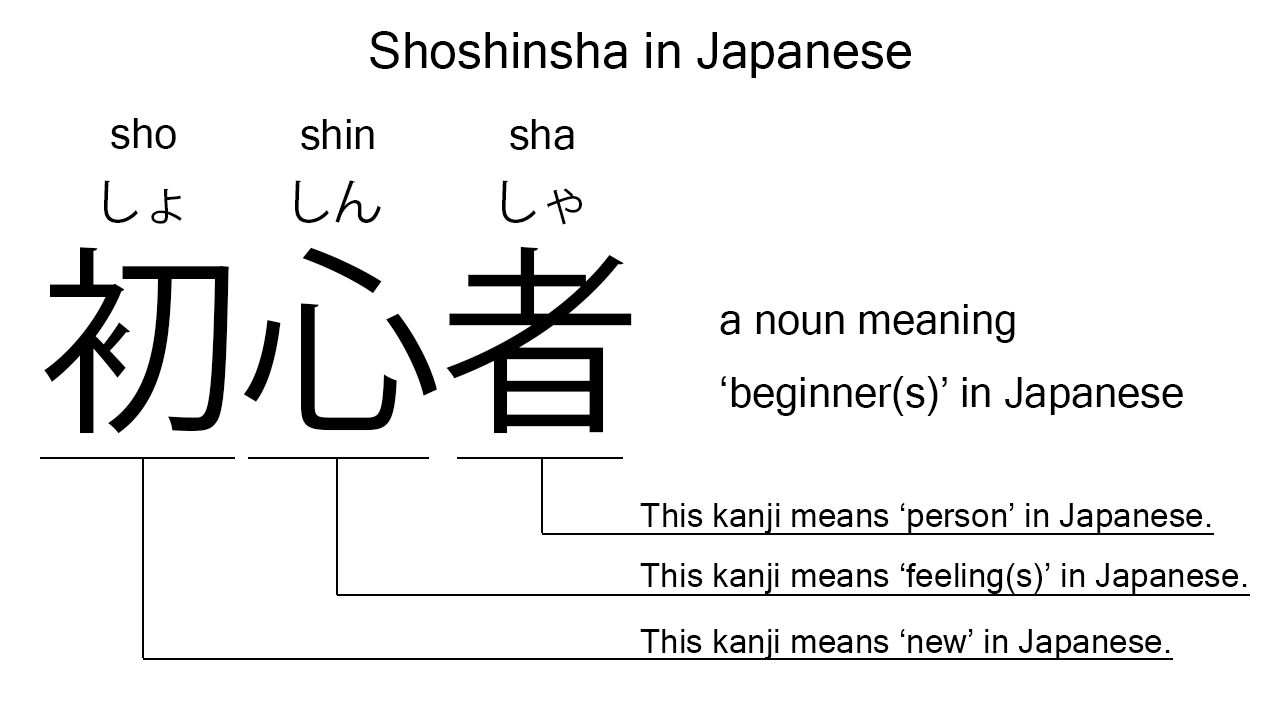What does “shoshinsha” mean in Japanese?
Native speakers say “shoshinsha” often to mean ‘beginner’ in Japanese. Perhaps, some Japanese learners know this word as it is sometimes used in Japanese textbooks. In this blog post, however, I will explain it in detail based on its kanji expression. And also, I will explain how to use it through example sentences. My explanations would help Japanese learners understand “shoshinsha” more clearly. Then, let’s get started!
Contents
Definition and meanings of “shoshinsha”
Let me start with the definition and meanings of “shoshinsha”.
- shoshinsha – 初心者 (しょしんしゃ) : a noun meaning ‘beginner’, ‘novice’, or ‘newbie’ in Japanese. This can also work as plural. Learn more about Japanese plural.
Japanese native speakers use this noun to refer to someone who has started something new recently.
The definition and meanings are not that difficult, I think. To understand this noun more clearly, however, let me explain its kanji characters in detail, one by one.
What does “shoshinsha” literally mean in Japanese?
The kanji expression of “shoshinsha” consists of the following three kanji characters:
- 初 : a kanji character used to mean ‘new’, ‘first’, or such in Japanese.
- 心 : a kanji character used to mean ‘heart’, ‘feeling’, or such in Japanese.
- 者 : a kanji character sometimes used to add the meaning of ‘person’.
From these three kanji characters, we can understand that “shoshinsha” literally means a ‘person with new feelings’ in Japanese. This literal interpretation is not completely in line with the actual meanings, but still understandable, I think. Beginners often have new feelings about the things they have started recently.

When we meet new kanji expressions, we should check their kanji characters in detail to understand their meanings clearly and deeply. In many cases, kanji characters tell us a lot about the meanings of the expressions they form. Actually, here, we could get the better understanding of “shoshinsha” through the detailed kanji check above.
So far, I’ve explained the definition and meanings of “shoshinsha” together with its kanji characters. Then, let me explain how to use it through the example sentences below.
Example #1: how to say “beginners” in Japanese
watashi tachi wa min’na shoshinsha desu – 私達はみんな初心者です (わたしたちはみんなしょしんしゃです)
We are all beginners.
Below are the new words used in the example sentence.
- watashi – 私 (わたし) : a pronoun meaning ‘I’ in Japanese.
- tachi – 達 (たち) : a suffix used after a noun or pronoun to make its plural form. In the example, this is used after “watashi” to make its plural form, “watashi tachi”, which means ‘we’ in Japanese.
- wa – は : a binding particle working as a case marker or topic marker. In the example, this works after “watashi tachi” to make the subject in the sentence.
- min’na – みんな : a pronoun meaning ‘everyone’ in Japanese, but can also be used like an adverb to emphasize the meaning of a plural noun. In the example, this is used to add the meaning of ‘all’.
- desu – です : an auxiliary verb used after a noun or adjective to make it polite. Probably, this is well known as a part of Japanese desu form. In the example, this is used after “shoshinsha” to make it sound polite.
This is a typical usage of “shoshinsha”. In this example, it works as plural to mean ‘beginners’ in Japanese.
Example #2: another usage of “shoshinsha”
shoshinsha ni yasashiku shi te kudasai – 初心者に優しくしてください (しょしんしゃにやさしくしてください)
Please be kind to beginners.
Below are the new words used in the example sentence.
- ni – に : a case particle used to say to whom an action is directed. In the example, this is used after “shoshinsha” to say to whom the listeners should be kind.
- yasashiku – 優しく (やさしく) : one conjugation of the i-adjective, “yasashii“, which means ‘kind’ in Japanese. In the example, it has been conjugated for the better connection with its following word.
- shi – し : one conjugation of the verb, “suru”, which means ‘to do’, ‘to perform’, or such in Japanese. In the example, it has been conjugated for the better connection with its following word.
- te – て : a conjunctive particle used after a verb, adjective, or auxiliary verb to make its te form. In the example, this is used after “shi” to make its te form, “shi te”. Verbs need to be changed to their te forms to be connected with “kudasai”.
- kudasai – ください : one conjugation of the verb, “kudasaru”, which means ‘to give’ or such in Japanese. When this follows a verb, however, this can work like an auxiliary verb to add the meaning of ‘please’. In the example, this works like an auxiliary verb after “shi te” to add the meaning of ‘please’.
This is another typical usage of “shoshinsha”. In this example, it works together with the case particle, “ni”, to become the object in the sentence. Anyway, when we want to refer to someone who has started something new recently in Japanese, “shoshinsha” is a very good option.
Summary
In this blog post, I’ve explained the definition and meanings of “shoshinsha” in detail based on its kanji expression. And also, I’ve explained how to use it through the example sentences. Let me summarize them as follows.
- shoshinsha – 初心者 (しょしんしゃ) : a noun meaning ‘beginner’, ‘novice’, or ‘newbie’ in Japanese. This can also work as plural. These three kanji characters literally mean a ‘person with new feelings’ in Japanese. This literal interpretation is not completely in line with the actual meanings, but still understandable, I think. Beginners often have new feelings about the things they have started recently. Japanese native speakers use this noun to refer to someone who has started something new recently.
Hope my explanations are understandable and helpful for Japanese learners.
Leave a Reply